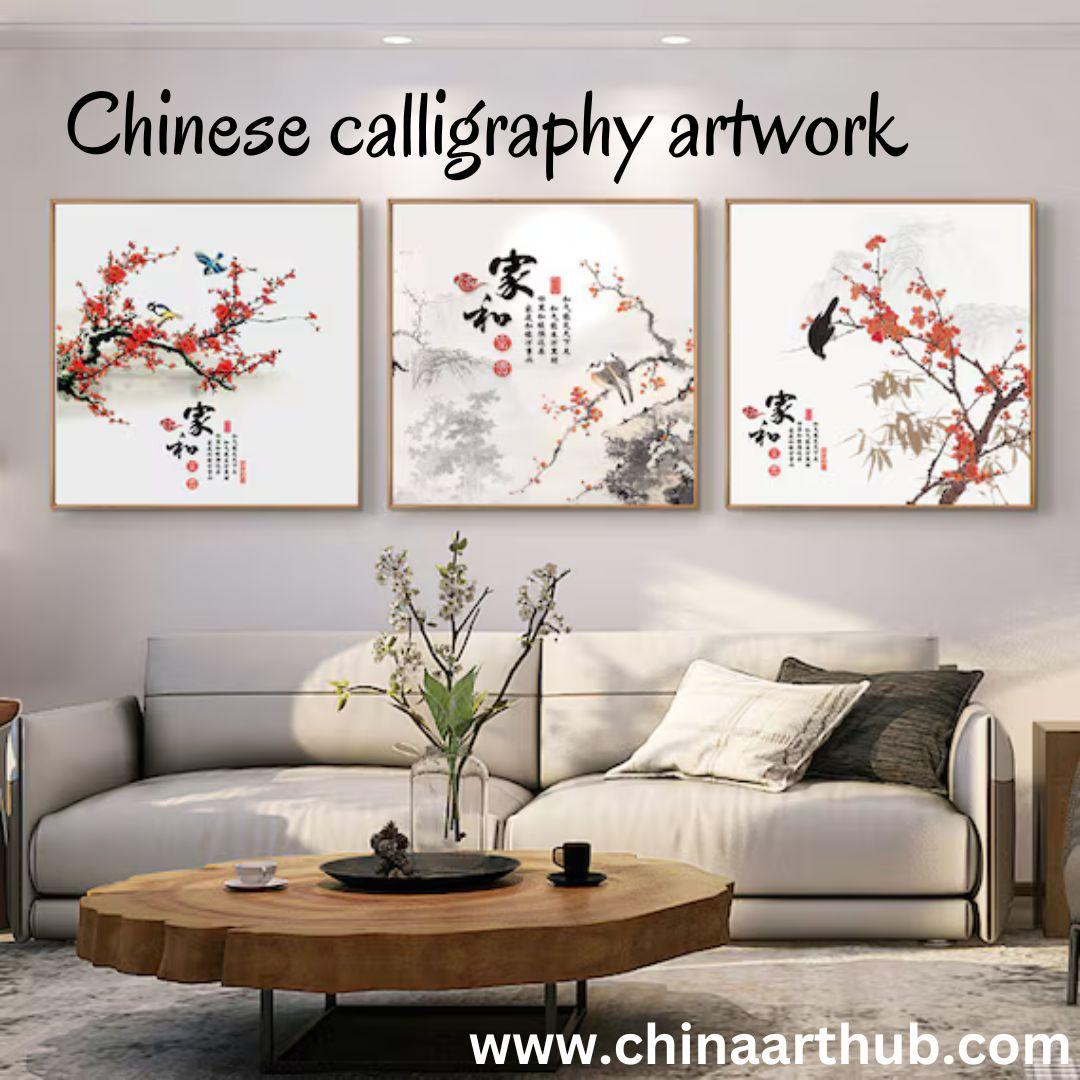What makes Chinese calligraphy artwork a profound expression of Chinese culture and history?

Chinese calligraphy artwork is one of the most distinguished and revered art forms in Chinese culture. With its deep historical roots, intricate techniques, and spiritual significance, it offers a window into the philosophical and aesthetic principles that have shaped China for centuries. More than just a form of writing, Chinese calligraphy artwork is a dynamic and transformative medium that embodies the beauty of language, the expression of emotion, and the reflection of the cultural landscape of ancient China.
This art form, which involves the skillful use of brushes, ink, and rice paper, has transcended its functional role as a means of communication. It is now regarded as a sophisticated and celebrated artistic expression, imbued with cultural, philosophical, and spiritual value. From ancient scrolls to contemporary artworks, Chinese calligraphy continues to inspire artists, collectors, and cultural enthusiasts worldwide.
Historical Significance of Chinese Calligraphy Artwork
The history of Chinese calligraphy dates back over 3,000 years, evolving through dynasties and marking significant moments in the development of Chinese civilization. The earliest forms of Chinese calligraphy emerged during the Shang Dynasty (1600–1046 BC), when inscriptions were made on oracle bones. These early scripts were primarily used for divination purposes, and over time, the forms of writing became more standardized, giving rise to the various styles of Chinese calligraphy that we know today.
The significance of Chinese calligraphy can be seen in its connection to ancient philosophies such as Confucianism, Taoism, and Buddhism. Calligraphy was not only a practical tool for preserving written records but also a way for scholars to express their inner thoughts, emotions, and personal philosophies. Through the brush strokes, calligraphers communicated more than just words; they conveyed their souls, their connection to nature, and their place in the universe.
The Artistic Styles of Chinese Calligraphy
Chinese calligraphy artwork has evolved into several distinct styles, each with its own unique characteristics and historical context. The most well-known styles include:
-
Seal Script (篆书, Zhuànshū): This is one of the oldest and most ancient forms of Chinese calligraphy. Seal script was used predominantly in the Qin Dynasty (221–206 BC) for the engraving of seals. Its characters are rounded and stylized, resembling the impressions made on seals. Although less commonly used today, it remains a symbol of antiquity and is admired for its artistic and historical significance.
-
Clerical Script (隶书, Lìshū): Originating during the Han Dynasty (206 BC–220 AD), clerical script is characterized by bold, sweeping strokes and a more rectangular form. This style was a natural evolution from the earlier seal script and became the dominant style for administrative and official documents during its time.
-
Regular Script (楷书, Kǎishū): Regular script is the most widely used form of Chinese calligraphy today. It was formalized during the Tang Dynasty (618–907 AD) and is marked by precise, balanced strokes. This script is the foundation of modern Chinese writing and is often used for both artistic and practical purposes.
-
Running Script (行书, Xíngshū): Known for its fluidity and speed, running script was developed as a faster, more spontaneous form of calligraphy. It is less formal than regular script but retains legibility. The flowing nature of running script allows for greater expression of the calligrapher’s emotions.
-
Cursive Script (草书, Cǎoshū): The cursive script is the most expressive and free-flowing of all calligraphy styles. Characters are written in a highly stylized manner, with strokes often abbreviated or connected. This style emphasizes artistic expression over legibility and is typically used by advanced calligraphers who have mastered the fundamentals of the other scripts.
The Artistry Behind Chinese Calligraphy Artwork
The creation of Chinese calligraphy artwork is an intricate process that requires years of practice and mastery. Every brush stroke, whether bold or delicate, conveys a specific emotion and philosophy. Calligraphers often draw inspiration from their environment, from the natural world to their personal experiences, and use their brushes as a tool to communicate their inner worlds.
One of the key components of Chinese calligraphy is the brush itself. Traditional Chinese brushes are made from a variety of materials, including animal hair and bamboo, and are designed for fluid movement. The bristles are soft yet resilient, allowing for a wide range of strokes, from fine and delicate to bold and dramatic. The ink used in calligraphy is typically made from powdered ink sticks that are ground on an ink stone, producing a rich, deep black ink that enhances the aesthetic quality of the writing.
The paper or silk used to create Chinese calligraphy artwork is also essential to the final result. Rice paper, with its absorbent and textured qualities, is a preferred medium for traditional calligraphy. It allows the ink to bleed slightly, creating a sense of depth and movement in the strokes. Many calligraphers also use Chinese paper fans or scrolls as their canvas, further adding to the artwork’s sense of tradition and elegance.
The Symbolism and Philosophy Behind Chinese Calligraphy Artwork
Chinese calligraphy is deeply rooted in Chinese philosophy and spirituality. It is seen not only as an art form but as a way to cultivate the self and achieve harmony between the mind, body, and spirit. The brushwork in Chinese calligraphy is believed to reflect the calligrapher’s inner state, with each stroke representing a moment of mindfulness and contemplation.
The act of writing itself is a meditative process, and the calligrapher is expected to embody principles such as balance, harmony, and fluidity in their work. The brush is not merely a tool for writing; it becomes an extension of the self, and each stroke is a reflection of the calligrapher’s emotions and intentions. In this sense, Chinese calligraphy is a form of self-expression and a way to communicate the artist’s personal worldview.
Many Chinese calligraphers draw upon the philosophy of Taoism, which emphasizes the importance of simplicity, spontaneity, and connection with nature. This philosophy is reflected in the brush strokes, which often appear to flow effortlessly across the paper, capturing the essence of the natural world and the cosmos.
The Role of Chinese Calligraphy in Modern Art and Culture
While traditional Chinese calligraphy has its roots in the ancient past, its influence continues to resonate in contemporary art and culture. Many modern artists incorporate calligraphy into their works, blending traditional techniques with new materials and media. In the world of contemporary art, Chinese calligraphy has become a symbol of cultural pride, a way to preserve ancient traditions while embracing new artistic expressions.
In the digital age, Chinese calligraphy is also finding its place in graphic design, advertising, and fashion. Its elegant and expressive nature makes it a powerful tool for conveying emotion and sophistication, while its rich cultural heritage lends an air of prestige and authenticity.
Moreover, Chinese calligraphy has become a focal point for international art collectors and institutions. Many renowned galleries and museums around the world now feature Chinese calligraphy as part of their collections, highlighting its continued relevance and importance as an art form.
Final Thoughts:
Chinese calligraphy artwork is not just a form of writing; it is a profound reflection of Chinese history, culture, and philosophy. From its ancient origins to its modern-day influence, Chinese calligraphy continues to captivate and inspire people around the world. The intricate brushstrokes and timeless elegance of this art form transcend language and time, offering a deep connection to the spiritual and intellectual heritage of China.
For those who appreciate the beauty and depth of this ancient art form, Chinese calligraphy artwork offers a unique opportunity to engage with Chinese culture in a meaningful and personal way. Whether through the study of its various styles or the acquisition of original artworks, Chinese calligraphy continues to be a bridge between the past and the present, a living tradition that speaks to the soul.





